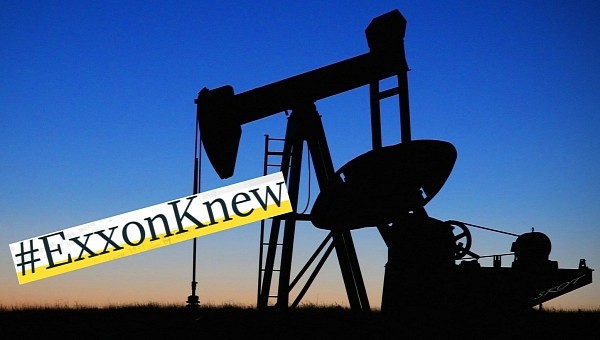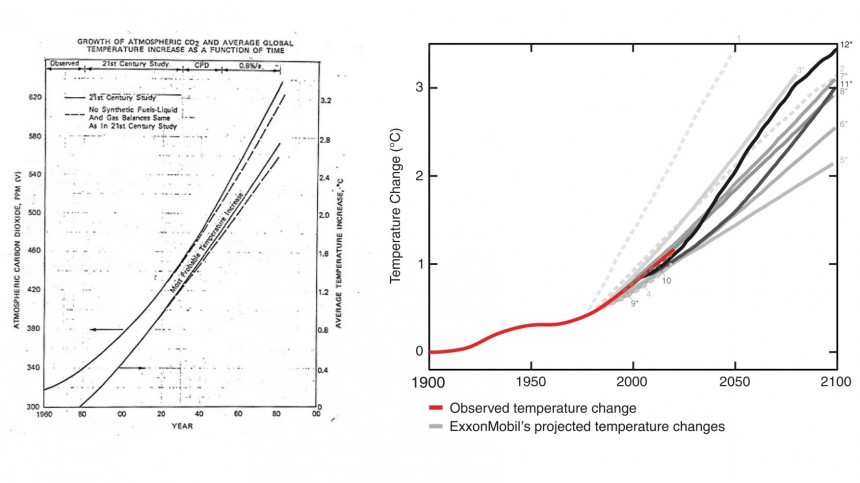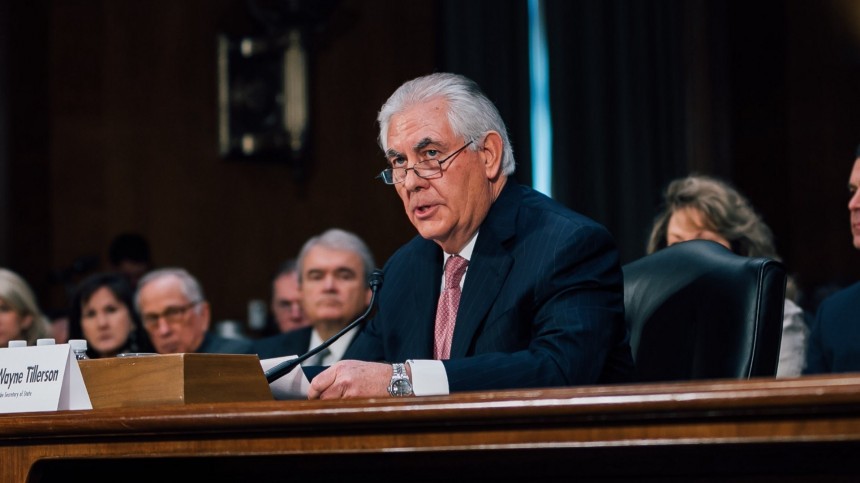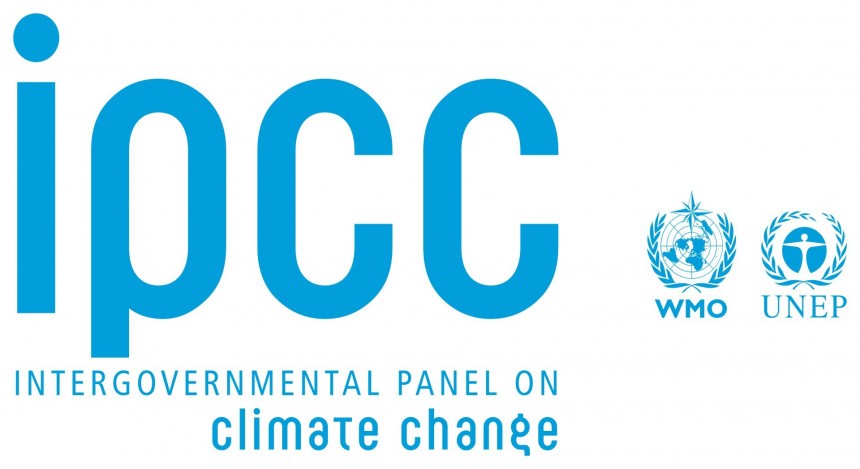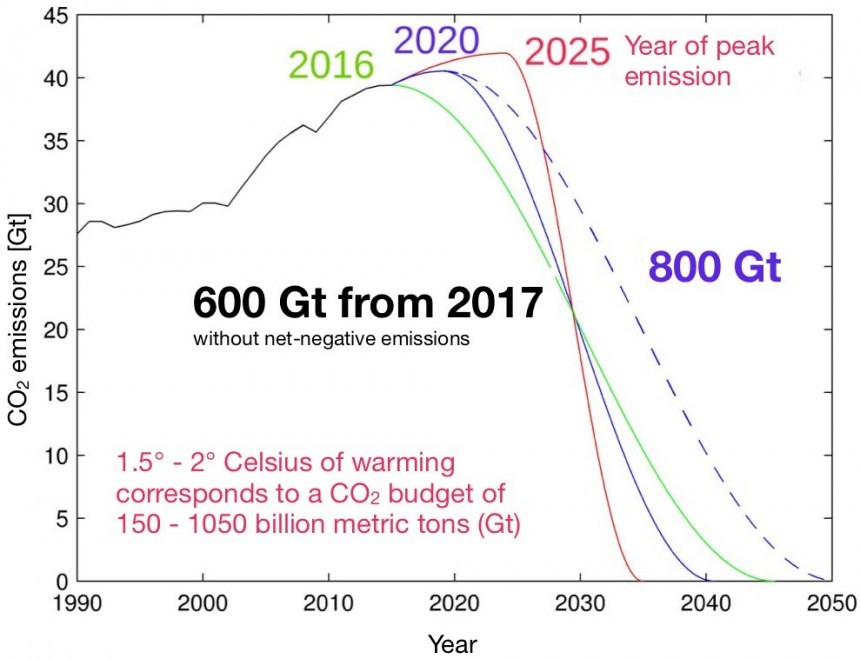In 2015, an investigation carried out by journalists revealed that oil company Exxon had known since the ‘70s that using fossil fuels could lead to a dramatic climate change scenario by 2050. Today #ExxonKnew activism movement is widespread, cities, counties, and states have filed dozens of lawsuits against oil corporations, and politicians are going ahead with hearings about climate change denial by Big Oil. But how did they manage to fool us all?
In December 2022, Puerto Rico filed a lawsuit against ExxonMobil. It’s the first-ever climate change RICO lawsuit against an oil major based on racketeering legislation. The 1970 Racketeer Influenced and Corrupt Organizations (RICO) Act was originally intended to combat criminal enterprises like the mafia.
Exxon is accused, along with other companies, of conspiring to deceive the public into thinking the current warming might not have been caused by man-made pollution and burning fossil fuels. There are also mentions of GM and Ford motor companies knowing about it since at least the 1970s.
It sounds like a C-grade conspiracy movie, but it’s simply a real story of a three-decades-long campaign of many oil companies and trade associations that spread disinformation and opposed climate policies.
ExxonMobil is the most important actor because, since the late 1970s and early 1980s, this major oil company’s scientists predicted global warming correctly and skillfully. But Exxon’s management decided to deny it and simply lie about it.
How did they do it? Using SCAM (the Scientific Certainty Argumentation Method) – a tactic for undermining public understanding of scientific knowledge. It was a long and carefully planned strategy, based on five pillars of large-scale propaganda.
There were dozens of studies and models from the 1970s onwards that accurately foresaw the threat of human-caused global warming.
For instance, a 1979 internal Exxon study concluded that:
- the increase [in atmospheric CO2] is due to fossil fuel combustion
- Increasing CO2 concentration will cause a warming of the earth's surface
- the present trend of fossil fuel consumption will cause dramatic environmental effects before the year 2050.
Recent investigations of internal Exxon documents revealed that more than half of the researchers’ projections in the ‘70s and ‘80s were consistent with historical observations. And also, more accurate than academic and government models of that time!
Basically, company scientists were warning management about the dramatic future outcome because of the fossil fuel industry. But Exxon management made a choice: to keep using fossil fuels and, in the meantime, emphasize uncertainties.
Every Thursday between 1972 and 2001, ExxonMobil bought advertorials in New York Times, at a discount price of $31,000 (in 2016 USD value, this is more than $40 million over 29 years!), and also one-quarter of all advertorials on op-ed.
The main subjects that were discussed over and over were:
- the uncertainty of climate science excludes the possibility of anthropogenic global warming; the main causes are of natural origin, ranging from a natural period of warming or solar activity to volcanic eruptions or El Nino phenomenon;
- there is no viable data to suggest that human-caused global warming would occur; there are a lot of other scientists that do not agree with the National Academy and IPCC;
- climate mitigation strategies will either fail or create bigger problems; the 1997 Kyoto Protocol would be “financially crippling,” “economy-wrecking,” and a “blow to U.S. prosperity.”
FYI: A psychological examination of the effects of these advertorials revealed that they substantially affect levels of individual issue salience. Readerships were in millions and they were non-science oriented. As a result, the “Doubt” arguments largely affected public opinion and consequently crippled political decisions.
The projection modeled by Exxon scientists is very high, ranging from 67 to 72% accuracy. For comparison, in 1988, NASA’s scientist James Hansen presented to the U.S. Congress warming predictions with a skill score ranging from 38 to 66%.
Basically, Exxon’s leading scientist themselves described their climate models as “sophisticated” and “state of the art”. And the historical evolution of climate is proof of this statement.
However, ExxonMobil’s communication and managers claimed in public that scientific climate models are “unreliable.” CEO Lee Raymond called it “unproven climate models, or, more often, sheer speculation.”
In 2015, his successor, Rex Tillerson, stated: “We do not really know what the climate effects of 600 ppm versus 450 ppm will be because the models simply are not that good.” But the company’s own modeling from 1982 suggested 30 years prior that 600 ppm of CO2 concentration in the atmosphere had a high chance to lead to 1.3°C (34.34 °F) than 450 ppm.
FYI: As of January 2023, the CO2 concentration in the atmosphere is almost 420 ppm, and this year climatologists warn us that El Nino is very likely to “help" global temperature to pass the 1.5 °C (34.7 °F) milestone.
In the early 2010s, government agencies predicted that this value would be reached around 2050. It’s now happening almost 30 years earlier, just as Exxon’s researchers predicted in several models created 30 years ago.
Exxon scientists’ models were in no case showing any sign of cooling. They referred to imminent global warming as a “carbon dioxide induced super-interglacial,” that would render Earth hotter than at any time in the last 150,000 years.
Exxon management received several memos on this literally hot subject, but they chose to cultivate the myth of “the 1970s global cooling scientific consensus.” There were many advertorials, public debates, and interviews with Exxon’s representatives on this false topic.
FYI: There are unverified reports of Exxon’s influence on creating the 2004 'The Day After Tomorrow' movie, starring Dennis Quaid, where Earth is suddenly trapped in an Ice Age massive climate shift because of global warming.
Twentieth Century Fox invited a group of scientists to preview the movie and most of them considered it an “enjoyable nonsense.” NASA scientists denied the request to be consultants in making the movie because the events in it were considered too ridiculous to actually occur.
In 1988, The World Meteorological Organization and the United Nations Environment Programme established the Intergovernmental Panel on Climate Change (IPCC) with the goal of advancing scientific knowledge about climate change caused by human activities.
The first ever IPCC assessment report was published in 1995 – in line with Exxon’s scientists’ predictions – and it stated that there was strong evidence of a human effect on global temperatures. In 2000 and in all subsequent IPCC assessment reports, the 'evidence' became 'strong confidence,' based on the scientific consensus.
As a response to IPCC, in 1989, Exxon (at that time Mobil) founded, along with other major producers and users of fossil fuels, the Global Climate Coalition (GCC). It was the largest industry group active in climate policy and the most prominent industry advocate in international climate negotiations.
Exxon called the scientific consensus as “contrarian theories that do not offer convincing arguments against the conventional model of greenhouse gas emission-induced climate change.” Or “scientific uncertainties continue to limit our ability to make objective, quantitative determinations regarding the human role in recent climate change.”
FYI: GCC dissolved in 2001 after public criticism over creating manufactured controversy and sowing doubt over the scientific consensus on climate change. GCC's comprehensive PR campaign was designed by E. Bruce Harrison, who had been creating campaigns for the U.S. industry against environmental legislation from the 1970s.
Investigators identified a dozen of documents on the stranded assets issue, related to five reports addressing the ideas of “cumulative fossil fuel use,” “cumulative CO2 emissions,” and ”carbon budgets for CO2 stabilization and/or climate mitigation.”
Those reports were published between 1982 and 2005 and their conclusion was that the carbon budget between 2015 and 2100 was 251 to 716 gigatons of carbon (GtC). They are pretty close to contemporary estimates of 442 to 651 GtC.
The problem is, nowadays, CO2 emissions are estimated to be more than 40 GtC/year. It means that in less than 20 years – which is by 2040 – humanity should totally divest from fossil fuels to avoid passing the 2 °C (35.6 °F) threshold.
This tends to be a major problem for Exxon’s investors and shareholders – it would be crazy to invest millions or billions of dollars in a company that you know for sure will collapse at a not-too-distant point in the future. Yet, ExxonMobil did not alert investors, consumers, or the general public to this constraint.
FYI: As a twist of fate, the recent turmoil caused by Russia’s invasion of Ukraine helped Exxon finance, which announced record quarterly profits at the end of 2022. Moreover, it unveiled a massive $50 billion stock buyback scheme, which is expected to boost its 2022 market capitalization of $440 billion.
Adding 'stranded assets' into the equation is like dropping a nuclear bomb on Exxon. So, it’s only natural for such a big corporation to keep silent and keep fueling its campaigns opposing policies to reduce greenhouse gas emissions.
Exxon is accused, along with other companies, of conspiring to deceive the public into thinking the current warming might not have been caused by man-made pollution and burning fossil fuels. There are also mentions of GM and Ford motor companies knowing about it since at least the 1970s.
It sounds like a C-grade conspiracy movie, but it’s simply a real story of a three-decades-long campaign of many oil companies and trade associations that spread disinformation and opposed climate policies.
ExxonMobil is the most important actor because, since the late 1970s and early 1980s, this major oil company’s scientists predicted global warming correctly and skillfully. But Exxon’s management decided to deny it and simply lie about it.
How did they do it? Using SCAM (the Scientific Certainty Argumentation Method) – a tactic for undermining public understanding of scientific knowledge. It was a long and carefully planned strategy, based on five pillars of large-scale propaganda.
1. ExxonMobil Corp emphasized the uncertainties of climate science and modeling
In the 1970s, Exxon Research and Engineering Company was the most advanced research department a private company could have. Regarding global warming projections, the Exxon scientists were considered brilliant and skillful, on par with many independent scientists of their day.There were dozens of studies and models from the 1970s onwards that accurately foresaw the threat of human-caused global warming.
For instance, a 1979 internal Exxon study concluded that:
- the increase [in atmospheric CO2] is due to fossil fuel combustion
- Increasing CO2 concentration will cause a warming of the earth's surface
- the present trend of fossil fuel consumption will cause dramatic environmental effects before the year 2050.
Recent investigations of internal Exxon documents revealed that more than half of the researchers’ projections in the ‘70s and ‘80s were consistent with historical observations. And also, more accurate than academic and government models of that time!
Every Thursday between 1972 and 2001, ExxonMobil bought advertorials in New York Times, at a discount price of $31,000 (in 2016 USD value, this is more than $40 million over 29 years!), and also one-quarter of all advertorials on op-ed.
The main subjects that were discussed over and over were:
- the uncertainty of climate science excludes the possibility of anthropogenic global warming; the main causes are of natural origin, ranging from a natural period of warming or solar activity to volcanic eruptions or El Nino phenomenon;
- there is no viable data to suggest that human-caused global warming would occur; there are a lot of other scientists that do not agree with the National Academy and IPCC;
- climate mitigation strategies will either fail or create bigger problems; the 1997 Kyoto Protocol would be “financially crippling,” “economy-wrecking,” and a “blow to U.S. prosperity.”
FYI: A psychological examination of the effects of these advertorials revealed that they substantially affect levels of individual issue salience. Readerships were in millions and they were non-science oriented. As a result, the “Doubt” arguments largely affected public opinion and consequently crippled political decisions.
2. ExxonMobil Corp denigrated climate models
The overall consensus among climate change scientists is that Exxon had very skillful researchers. They had access to first-hand data from the company database and also a very generous budget. Their models are considered among the best that science could produce at the time.The projection modeled by Exxon scientists is very high, ranging from 67 to 72% accuracy. For comparison, in 1988, NASA’s scientist James Hansen presented to the U.S. Congress warming predictions with a skill score ranging from 38 to 66%.
Basically, Exxon’s leading scientist themselves described their climate models as “sophisticated” and “state of the art”. And the historical evolution of climate is proof of this statement.
However, ExxonMobil’s communication and managers claimed in public that scientific climate models are “unreliable.” CEO Lee Raymond called it “unproven climate models, or, more often, sheer speculation.”
FYI: As of January 2023, the CO2 concentration in the atmosphere is almost 420 ppm, and this year climatologists warn us that El Nino is very likely to “help" global temperature to pass the 1.5 °C (34.7 °F) milestone.
In the early 2010s, government agencies predicted that this value would be reached around 2050. It’s now happening almost 30 years earlier, just as Exxon’s researchers predicted in several models created 30 years ago.
3. ExxonMobil Corp heavily mythologized 'global cooling'
The vast majority of scientists and peer-reviewed literature in the 1970s stated that, because of human-caused global warming, global cooling was unlikely to take place. Only around 14% of the peer-reviewed literature anticipated a minor natural ice age.Exxon scientists’ models were in no case showing any sign of cooling. They referred to imminent global warming as a “carbon dioxide induced super-interglacial,” that would render Earth hotter than at any time in the last 150,000 years.
FYI: There are unverified reports of Exxon’s influence on creating the 2004 'The Day After Tomorrow' movie, starring Dennis Quaid, where Earth is suddenly trapped in an Ice Age massive climate shift because of global warming.
Twentieth Century Fox invited a group of scientists to preview the movie and most of them considered it an “enjoyable nonsense.” NASA scientists denied the request to be consultants in making the movie because the events in it were considered too ridiculous to actually occur.
4. ExxonMobil Corp claimed ignorance about discernibility
In private and academic circles since the late 1970s and early 1980s, ExxonMobil scientists accurately predicted when human-caused global warming would first be detected. Their average projected warming was 0.20° ± 0.04°C per decade, thus they informed Exxon management that anthropogenic global warming is going to be acknowledged by authorities in the year 2000 ± 5.In 1988, The World Meteorological Organization and the United Nations Environment Programme established the Intergovernmental Panel on Climate Change (IPCC) with the goal of advancing scientific knowledge about climate change caused by human activities.
The first ever IPCC assessment report was published in 1995 – in line with Exxon’s scientists’ predictions – and it stated that there was strong evidence of a human effect on global temperatures. In 2000 and in all subsequent IPCC assessment reports, the 'evidence' became 'strong confidence,' based on the scientific consensus.
Exxon called the scientific consensus as “contrarian theories that do not offer convincing arguments against the conventional model of greenhouse gas emission-induced climate change.” Or “scientific uncertainties continue to limit our ability to make objective, quantitative determinations regarding the human role in recent climate change.”
FYI: GCC dissolved in 2001 after public criticism over creating manufactured controversy and sowing doubt over the scientific consensus on climate change. GCC's comprehensive PR campaign was designed by E. Bruce Harrison, who had been creating campaigns for the U.S. industry against environmental legislation from the 1970s.
5. ExxonMobil Corp kept silent on stranded assets
The concept of stranded fossil fuel assets is related to the 'carbon budget' – the amount of CO2 emissions that can be added to the atmosphere by 2011 to keep anthropogenic global warming below 2 °C (35.6 °F), related to pre-industrial levels.Investigators identified a dozen of documents on the stranded assets issue, related to five reports addressing the ideas of “cumulative fossil fuel use,” “cumulative CO2 emissions,” and ”carbon budgets for CO2 stabilization and/or climate mitigation.”
Those reports were published between 1982 and 2005 and their conclusion was that the carbon budget between 2015 and 2100 was 251 to 716 gigatons of carbon (GtC). They are pretty close to contemporary estimates of 442 to 651 GtC.
This tends to be a major problem for Exxon’s investors and shareholders – it would be crazy to invest millions or billions of dollars in a company that you know for sure will collapse at a not-too-distant point in the future. Yet, ExxonMobil did not alert investors, consumers, or the general public to this constraint.
FYI: As a twist of fate, the recent turmoil caused by Russia’s invasion of Ukraine helped Exxon finance, which announced record quarterly profits at the end of 2022. Moreover, it unveiled a massive $50 billion stock buyback scheme, which is expected to boost its 2022 market capitalization of $440 billion.
Adding 'stranded assets' into the equation is like dropping a nuclear bomb on Exxon. So, it’s only natural for such a big corporation to keep silent and keep fueling its campaigns opposing policies to reduce greenhouse gas emissions.
